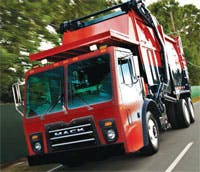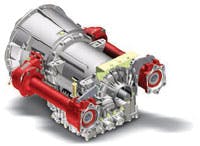Even though hydraulics is the most compact method of power transmission in the industrial world, it can still be a challenge to find enough space to mount a pump. This is especially true with work trucks. A heavy truck’s transmission is usually fitted with one or more power takeoffs (PTOs), to which a pump can be connected for transmitting auxiliary hydraulic power. The problem is, the transmission is almost always surrounded by framework and chassis and floor panels that don’t leave much space for a very big pump — much less installing or working on one.
To circumvent this problem, Parker Hannifin’s Chelsea Products Div., Olive Branch, Miss., recently introduced its Series 891 PTO. The 891 fits Series 4000 to 4500 series transmissions and comes in six speed ratios, seven output types and six shift options. Perhaps more importantly, it reorients the mounting flange for the hydraulic pump to an area that is more accessible and that allows more mounting space, so larger pumps can be specified.
The PTO on a series 4000 to 4500 series transmission is oriented so that the center axis of the hydraulic pump is perpendicular to the center axis of the transmission. However, the Chelsea 891 contains a pair of bevel gears that reorients the rotational power by 90°, making it parallel to the transmissions axis. An extension then transmits rotational power to the rear of the transmission, where a flange is provided for mounting a hydraulic pump. Depending on the model, the PTOs output flange can be rotated, providing even greater access to the pump.
Keep it wet
But even if space and accessibility don’t pose particular problems, a common and potentially costly issue surrounding PTOs in today’s work trucks is spline fretting. Spline fretting is corrosion that occurs at the spline where the PTO mates with the pump shaft. Torsional vibration can prematurely wear out the interface between the PTO and pump. Trucks that run continuously and are lightly loaded are especially susceptible to spline fretting, but work trucks requiring long PTO running times and high torque can also undergo increased fretting. This type of failure can be cost thousands of dollars in parts, labor, and lost revenue.
Regular regreasing has been a common remedy to stave off fretting. Regreasing requires detaching all associated parts, cleaning them, then separately regreasing each part before reattaching them.
To prevent fretting corrosion — and eliminate the need for preventive maintenance — Chelsea Products introduced Wet Spline technology to its line of PTOs. Chelsea’s Wet Spline pump flanges provide a continuous bath of fresh oil at the mating point of the PTO and pump shaft. The cushion of oil virtually eliminates spline fretting and increases the shaft life by a factor of 10. Chelsea recommends only a yearly inspection of the mating components when using their Wet Spline technology. Greaseable shafts, on the other hand, require monthly inspections.
Much of this information was provided by Jeff King, of Parker’s Chelsea Products Div. For more information, call (662) 895-1011 or e-mail [email protected].



